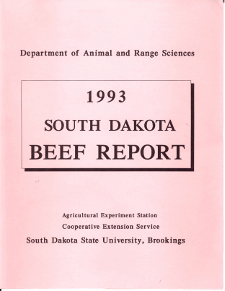Document Type
Report
Report Number
93-9
Publication Date
1993
Keywords
distillers grains, receiving, step-up, cattle
Summary
Two hundred sixty-four yearling steers with an initial average weight of 730 Ib were randomly allotted to 24 pens and fed ad libitum either conventional (CONV) receiving or step-up diets (hay content decreased from 50% to 40, 30, 20, and 10% of diet dry matter) or high energy (HE) diets (hay content was maintained throughout at 10% but wet corn distillers grain (WDG) decreased from 43% to 30, 20, 10, and 0%). The feeding of WDG in place of hay was designed to maximize energy intake while not overloading the rumen with starch during the grain adaptation period. Long grass hay was fed on day 1. Diets 1 through 4 were fed 7, 5, 6, and 4 days, respectively. Diet 5 (finishing diet) composition was the same for both treatments and was fed for 5 days. Average daily gain (CONV = 4.39 and HE = 4.41 Ib per day) during the 28-day receiving/step-up trial was not affected by diet composition (P >. 10). However, dry matter intake was 22% less (P<.001) for cattle fed the HE diets (16.0 vs 20.5 1b per day), resulting in a 23% improvement (P<.001) in feed efficiency (feed:gain 3.68 vs 4.76). Although HE diets also contained more protein than CONV diets, equal gains suggest protein was not limiting. The inclusion of low starch, high energy feeds such as WDG in receiving and step-up diets may improve efficiency but not rate of gain.
Number of Pages
5
Format
application/pdf
Language
en
Publisher
South Dakota State University
Rights
Copyright © 1993 South Dakota State University.
Recommended Citation
Birkelo, C. P. and Lounsbery, J., "Conventional Versus High Energy Receiving and Step-Up Diets for Feedlot Cattle" (1993). South Dakota Beef Report, 1993. 10.
https://openprairie.sdstate.edu/sd_beefreport_1993/10

